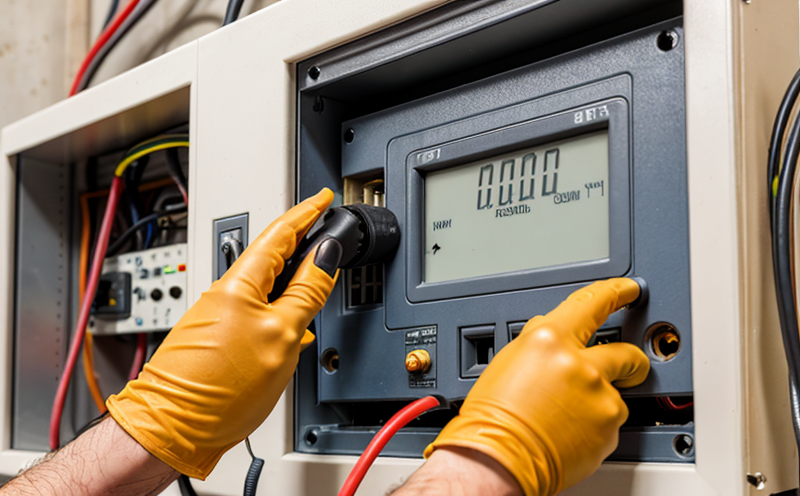SAE J2380 Functional and Electrical Testing of Battery Packs under Vibration
The SAE J2380 standard provides a comprehensive framework for testing battery packs under controlled vibration conditions to ensure their functional integrity and electrical performance. This testing method is crucial in the automotive, aerospace, and renewable energy sectors where reliability and safety are paramount.
Battery packs subjected to vibration can experience mechanical stresses that may lead to internal short circuits or loosened connections, which could compromise both the battery's operational efficiency and safety. SAE J2380 addresses these concerns by simulating real-world conditions through precise vibration profiles, ensuring that any potential issues are identified early in the development process.
The testing procedure involves placing a battery pack on a shaker table that can replicate various types of vibrations found during transportation or use. The test setup includes sensors to monitor voltage, current, temperature, and other critical parameters continuously throughout the vibration cycle. This allows for real-time assessment of how each parameter is affected by the imposed stress.
The SAE J2380 standard specifies a range of frequency bands and amplitudes that are representative of common environmental conditions encountered in different applications. For instance, automotive batteries might undergo tests simulating road roughness or braking events, while aerospace applications could involve more severe shock and vibration scenarios due to launch dynamics.
The test duration varies depending on the specific requirements but typically ranges from a few minutes up to several hours. During this period, engineers closely observe changes in performance metrics such as internal resistance, capacity retention, and thermal stability. Any deviations from expected behavior are recorded for further analysis.
Once testing concludes, detailed reports are generated summarizing all observed data points along with interpretations regarding compliance or non-compliance with specified limits outlined within the standard. These insights help manufacturers make informed decisions about design improvements aimed at enhancing durability and reliability across all operational environments.
The SAE J2380 methodology ensures robustness against external disturbances while maintaining high levels of quality assurance throughout production cycles. By adhering to this stringent protocol, companies can build confidence among consumers regarding the longevity and safety features offered by their products.
Why Choose This Test
Selecting SAE J2380 functional and electrical testing for battery packs under vibration offers several advantages that cater to various stakeholders involved in product development:
- Enhanced Reliability: Identifying potential weaknesses early helps prevent failures later in the lifecycle, thereby increasing overall reliability.
- Compliance Assurance: Meeting industry standards like SAE J2380 ensures compliance with regulatory requirements, facilitating smoother market entry processes.
- Cost Efficiency: Early identification of defects reduces costs associated with late-stage rework or recalls.
- Innovation Support: Providing a robust foundation for continuous improvement initiatives based on empirical evidence gathered during tests.
Beyond mere compliance, this testing approach fosters innovation by encouraging manufacturers to explore new materials and designs that can withstand harsher environments without compromising performance. It also promotes better communication between various departments within an organization, fostering teamwork towards achieving common goals related to product excellence.
By leveraging SAE J2380 functional and electrical testing of battery packs under vibration, companies not only meet current regulatory expectations but also position themselves ahead of competitors by delivering superior products that stand the test of time.
Quality and Reliability Assurance
The importance of ensuring quality and reliability cannot be overstated when it comes to battery packs. These components play a pivotal role in numerous industries, from automotive manufacturing to renewable energy systems. Any compromise on their integrity can have severe consequences ranging from reduced lifespan to safety hazards.
Quality assurance (QA) through rigorous testing like SAE J2380 is essential for maintaining consistent performance levels across all units produced. This involves meticulous attention to detail during every stage of production, including raw material selection, manufacturing processes, and final assembly. By adhering strictly to established protocols such as those defined by SAE J2380, manufacturers can minimize variability in outcomes and deliver standardized products.
Reliability assurance (RA) focuses on sustaining performance over extended periods under varying conditions. This requires ongoing monitoring of critical parameters like voltage, current, temperature, etc., using advanced instrumentation capable of providing real-time feedback during testing sessions. Such continuous surveillance enables early detection of emerging trends indicative of impending failures or degradation patterns.
Through comprehensive QA and RA practices supported by robust testing methodologies such as SAE J2380, companies can build trust with their customers while simultaneously reducing risks associated with product recalls or warranty claims. Ultimately, this contributes to building a reputation for excellence that sets them apart from competitors in highly competitive markets.
International Acceptance and Recognition
The SAE J2380 standard has gained widespread acceptance across multiple regions due to its comprehensive approach to evaluating battery packs under vibration. This international recognition underscores the importance placed on this testing methodology by various regulatory bodies around the world.
In North America, particularly within the United States and Canada, organizations involved in automotive manufacturing and renewable energy projects often adopt SAE J2380 as part of their quality control procedures. The American Society for Testing and Materials (ASTM) has also incorporated aspects of this standard into its own guidelines, further emphasizing its relevance.
Similarly, European countries like Germany, France, and the United Kingdom recognize the value added by SAE J2380 in ensuring product safety and reliability. Institutions such as VDE (Verband Deutscher Elektrotechniker) have referenced this standard in their recommendations for certification purposes.
The Asia-Pacific region has seen increasing adoption of SAE J2380 standards too, especially among manufacturers operating within the growing electric vehicle and solar power sectors. Standards organizations like BSI (British Standards Institution) and JISC (Japanese Industrial Standards Committee) have acknowledged its significance.
By aligning with internationally accepted practices such as SAE J2380, companies demonstrate their commitment to meeting global standards of excellence. This alignment not only facilitates easier cross-border trade but also enhances brand reputation among discerning consumers who value proven quality and reliability.





